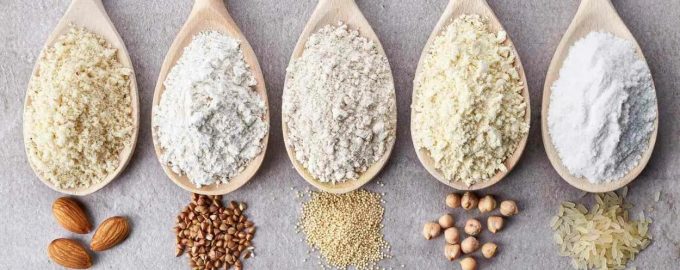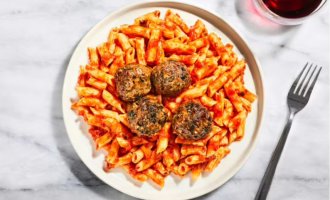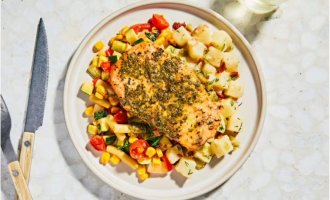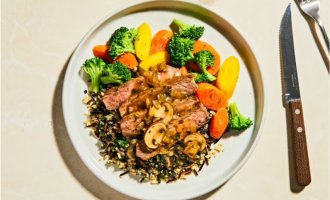Flour doesn’t generally strike us as nutritious (and neither do the baked goods we associate it with). And those in the gluten-free community have their own battles to pick with it, for sure. But the traditional white powder isn’t your only option out there—there’s a whole world of flour alternatives worth considering:
“They’re a great way to sneak extra nutrients like fiber and protein into your diet,” says Jessica Cording, MS, RD, a registered dietitian in New York City, about these alternative flours. “Plus, they can help you experiment with different flavors and textures.” That means swapping out all-purpose flour for coconut flour might just give your favorite cookie recipe the chewiness you’ve been looking for.
What’s the healthiest type of flour?
While there isn’t just one healthy type of flour, looking for flour alternatives with more nutrient-dense ingredients is the way to go. From nuts to brown rice, to beans, these flours will add fiber and other nutrients to your meal.
Almond flour
Just like the nuts themselves, almond flour (which is made from almonds that have been blanched and finely ground) is rich in protein, fiber, and healthy fats, says Cording. In fact, it has twice the protein and fiber of regular flour.
On top of that, this flour alternative has a slightly sweet, nutty flavor many people love and the fine texture makes it pretty versatile (we use it to get a greaseless finish on our Sicilian-Style Chicken Parm and Homestyle Chicken). “It does well when you’re making baked goods or breading something,” notes Cording.
How To Use It: Almond flour is a perfect flour alternative to baking, especially for moist baked treats (like pancakes or cupcakes). It’s not as good for artisanal crusty bread. When substituting, you’ll want to use less almond flour than you would white flour due to the higher fat content.
Brown rice flour
If you’ve never tried gluten-free flours before, this healthy option is a good place to start, notes Cording. “It has a very mild flavor and texture, which makes it good for everything from cookies to a coating for chicken or fish,” she says. It also has more fiber than regular flour and is high in B6 (a critical vitamin that performs a variety of functions in the body) and manganese, which may help keep bones healthy.
How To Use It: Brown rice flour can make your baked goods a little brittle, so experiment with adding more liquid (like applesauce, oil, or an extra egg). It also helps to bake at roughly 25 degrees lower than the recipe calls for.;
Coconut flour
This is one of Cording’s favorite flour alternatives, especially for baked goods. “If you’re making something more dense, it provides a really rich texture,” she says. Made from dried coconut pulp that’s ground up, it has a natural sweetness and a lower glycemic index than all-purpose flour (so it won’t cause your blood sugar to spike). Plus, it’s high in fiber, which helps keep you fuller longer.
The only downside to coconut flour is that it’s high in saturated fat but Cording notes that in moderation, this type of fat shouldn’t be a concern for most people. Just keep it in mind in case a recipe also calls for coconut oil or eggs, which are also high in saturated fat.
How To Use It: Less is more when it comes to coconut flour. You only need ⅓ or ¼ cup of coconut flour for each cup of flour you substitute. Since there’s no gluten to bind the recipe together, you also may need to up the eggs in the recipe. Try one egg for every ¼ cup of coconut flour.
Chickpea flour
Chickpea pasta is having a moment—and it’s safe to say its cousin, chickpea flour, is, too. The reason: It’s high in protein and fiber: a fourth of a cup of this alternative flour has five grams of each. Made from dried, finely ground garbanzo beans, it has an earthy flavor that makes it the perfect binder in savory dishes like meatballs. Cording notes that it’s also ideal for baked goods, like bread and biscuits. “It provides a dense, chewy texture,” she says.
How To Use It: Chickpea flour is great for bread baking – substitute half of the all purpose flour for chickpea flour for added nutrients and a familiar consistency. Chickpea flour also works when frying, or try using it to bind fritters, veggie burgers, or meatballs.
Cassava flour
This lesser-known alternative flour is made from cassava (aka yuca), a root veggie native to South America that’s similar to other starchy vegetables like carrots and parsnips. It’s higher in carbohydrates than other flour substitutes (a fourth of a cup contains 31 grams compared to just 5 grams in almond flour) but it’s a good source of flour. And, “it’s a great choice if you have a nut allergy,” says Cording.
Because of its creamy color and neutral flavor, it’s the perfect flour substitute for both sweet and savory dishes. At Freshly, we use it to coat our Golden Oven-Fried Chicken & Mash and fan favorite Buffalo Chicken.
How To Use It: Be careful when handling cassava flour as it’s pretty dusty and will get everywhere! Most recipes say you can substitute 1:1 ratio of cassava for all purpose flour, but like these other alternative flours, it’s a good idea to scale back to at least ¾ of a cup, and you may require some extra liquid.
- Almond Flour 607 kcal
- Barley Flour 367 kcal
- Buckwheat Flour 351 kcal
- Chickpea Flour 400 kcal
- Oat Flour 400 kcal
- Pea Flour 122 kcal
- Rice Flour 360 kcal
- Rye Flour 300 kcal
- Sesame Flour 382 kcal
- Soy Flour 433 kcal
- Spelt Flour 367 kcal
- Wheat Flour 345 kcal
- Whole Grain Amaranth Flour 367 kcal
- Yellow Whole-Grain Corn Flour 361 kcal
Why is flour bad for you?
White flour has very little nutritional value. It’s high in carbohydrates and calories, and low in everything else like fiber, protein and vitamins. White flour is stripped of its nutrients during processing, when the bran and germ part of the grain are removed leaving only the endosperm. This is the essential difference between whole wheat (brand, germ, and endosperm) versus just the starchy endosperm product in white flour. Bleached white flour is also treated with a chlorine gas to make it whiter.
Eating white flour can also cause insulin spikes. Products made with white four have a higher carbohydrate content than similar products with whole grains. For example, white bread has 74 net carbs with 2 grams of fiber but wheat bread has 48 net carbs with 3 grams of fiber.






